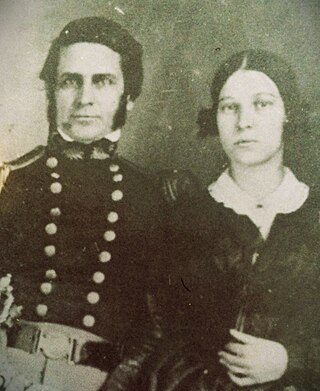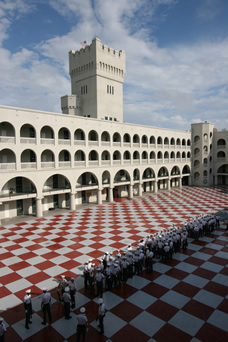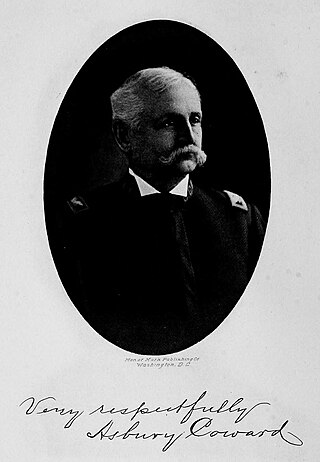
The Citadel Military College of South Carolina is a public senior military college in Charleston, South Carolina, United States. Established in 1842, it is the third oldest of the six senior military colleges in the United States. The Citadel was initially established as two schools to educate young men from around the state, while simultaneously protecting the South Carolina State Arsenals in both Columbia and Charleston.

Hugh Smith Thompson was the 81st governor of South Carolina, from 1882 to 1886.

Charleston, South Carolina, was a hotbed of secession at the start of the American Civil War and an important Atlantic Ocean port city for the fledgling Confederate States of America. The first shots against the Federal government were those fired there by cadets of the Citadel to stop a ship from resupplying the Federally held Fort Sumter. Three months later, the bombardment of Fort Sumter triggered a massive call for Federal troops to put down the rebellion. Although the city and its surrounding fortifications were repeatedly targeted by the Union Army and Navy, Charleston did not fall to Federal forces until the last months of the war. Charleston was devastated.

Ellison Capers was a Confederate general in the American Civil War, theologian, college professor and administrator from South Carolina.
The South Carolina Military Academy was a predecessor, two-campus institution to The Citadel. It was established in 1842 by the South Carolina Legislature and classes began at the Arsenal (Columbia) in 1843. South Carolina had constructed a series of arsenals around the state after the Denmark Vesey planned slave revolt of 1822; these were consolidated into Columbia and Charleston arsenals. No longer seen as militarily necessary, they became in 1842 the South Carolina Military Academy, consisting of the Arsenal Academy in Columbia and the Citadel Academy in Charleston. During the Civil War students from both served as the Battalion of State Cadets; SCMA cadets were among the battalion which fired the first shots of the Civil War on January 9, 1861 while manning a gun emplacement on Morris Island, South Carolina which shelled the Union steamship Star of the West; the Battalion of State Cadets made up over a third of a Confederate force that defended a strategic rail bridge in the Battle of Tulifinny in 1864. The Arsenal Academy was burned by Union troops in 1865 and never reopened; the only surviving building became the South Carolina Governor's Mansion. The Citadel Academy and the South Carolina Military Academy closed in 1865; its buildings were in Federal hands until 1882. An 1882 act of the South Carolina Legislature reopened the South Carolina Military Academy, using only the campus in Charleston. Known commonly as The Citadel Academy, the school was renamed in 1910 as The Citadel, after the name "Academy" became common to high schools rather than colleges. The school was moved to its current location in the 1960s.

Hugh Pate Harris was a United States Army four-star general who served as Commanding General, U.S. Continental Army Command from 1964 to 1965.

Richard Woodward Colcock was the second Superintendent of the South Carolina Military Academy from 1844 through 1852.

Major James Lide Coker was a businessman, merchant, industrialist, Christian philanthropist, and Civil War veteran, and the founder of Sonoco Products Company and Coker College. He was called "The Major" after his service in the Confederate Army.

Robert Louis Caslen Jr. is a retired United States Army officer who served as the 59th superintendent of West Point from 2013 until 2018 and as the 29th president of the University of South Carolina from July 2019 until May 2021. Between January and May 2019, Caslen was senior counsel to the president and interim chief financial officer at the University of Central Florida. On July 19, 2019, the Board of Trustees of the University of South Carolina elected him as the school's 29th president, a position he assumed on August 1, 2019. Caslen also served as HigherEchelon's Special Advisor on Executive Leadership and Character Development. He resigned as President at South Carolina on May 12, 2021.

The Battle of Tulifinny was a military engagement of the American Civil War that was fought from December 6–9, 1864 in Jasper County, South Carolina during Sherman's March to the Sea. Outnumbered five-to-one, a Confederate force led by Major-General Samuel Jones, consisting in part of the entire cadet corps of the South Carolina Military Academy, successfully defended a strategically important section of the Charleston and Savannah Railway from attacks by Union forces. The engagement was one of the rare occasions when the United States Marine Corps fought in combat during the conflict and was also the only occasion that the entire student body of a U.S. college fought in combat.

The South Carolina State Arsenal in Charleston, South Carolina was built in 1829 in response to the alleged 1822 slave revolt led by Denmark Vesey. The alleged uprising never came to fruition and Vesey was publicly hanged in 1822. In 1842 the South Carolina Military Academy, a liberal arts military college, was established by the state legislature, and the school took over the arsenal the following year as one of 2 campuses, the other being the Arsenal Academy in Columbia, South Carolina. The school became known as the Citadel Academy because of the appearance of its building. From 1865 to 1881, during Reconstruction, Federal troops occupied the Citadel, and the school was closed. Classes resumed in 1882 and continued in this building until the school was relocated to a new campus on the banks of the Ashley River in 1922.

The History of The Citadel began in the early 1820s with the formation of a militia and state arsenal in response to an alleged slave revolt in 1822. By 1842 the arsenal grew into an academy, with the Legislature establishing it as the South Carolina Military Academy. Cadets played a key role in the Civil War, by assisting in the battalion firing upon a federal ship three months before the war began. Many Confederate officers attended the school. Renamed in 1910 as The Citadel, the school's academic reputation grew. After moving the campus near Hampton Park in 1922, the college has grown substantially. Sixteen years after legal segregation ended in public schools, the Citadel saw the graduation of its first Black student, Charles D. Foster, in 1970. The first woman to graduate from The Citadel, Maxine Hudson, received her degree from the graduate program in 1969. Maxine was a distinguished and beloved teacher in Charleston for over 50 years. After a rocky journey, The Citadel graduated its first female Cadet from the Corps of Cadets program at the school, future congresswoman Nancy Mace, in 1999. The school has produced many military officers, business, and political leaders throughout its history.

The campus of the Citadel Military College of South Carolina consists of a 300-acre (120 ha) space adjacent to Hampton Park in Charleston, South Carolina. It has been home to the Citadel Military College of South Carolina since 1922 when the school moved from its location on Marion Square, including the Old Citadel. Arranged with the primary buildings surrounding a central 10-acre (4 ha) parade ground, it consists of barracks for the Corps of Cadets, academic buildings, a mess hall, chapel, library, athletic and recreational facilities, support buildings, and housing for faculty and staff.

The Arsenal Academy was a military academy in Columbia, South Carolina, originally established in 1842 as an independent school by the state of South Carolina. In 1845, the academy became a component of the South Carolina Military Academy, in which first year cadets underwent their initial year of training before completing their studies at the larger Citadel Academy in Charleston, South Carolina. The school was burned by Sherman's forces in 1865 and never reopened.

Peter Fayssoux Stevens was an American soldier, educator and clergyman. He was an officer in the Confederate States Army and a bishop in the Reformed Episcopal Church who also served as 4th superintendent of the South Carolina Military Academy.

Colonel John Peyre Thomas Sr. was an educator, politician and historian who served as 6th Superintendent of the South Carolina Military Academy.
Colonel Oliver James Bond, South Carolina Militia was an American educator and college administrator who served as both Superintendent and President of The Citadel from 1908 to 1931.

Asbury Coward was a school leader, Confederate Army officer, South Carolina Superintendent of Education. He served as Superintendent of The Citadel.
The Daniel Library is the main library of The Citadel, and is located on the college's Charleston, South Carolina campus. The library holds approximately 180,000 volumes in addition to extensive digital collections.



































